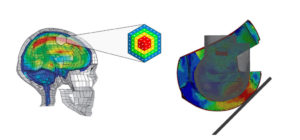MIPS unveils Finite Element Analysis Tool for helmet testing
In recent years, the cycling industry has redirected its focus to understanding the importance of helmet safety and how the brain can be affected not just in the immediate aftermath of a bike crash, but down the line.
In its attempt to make helmets safer, MIPS AB, has unveiled its Finite Element Analysis (FEA) tool which uses state-of-the-art computer science to replicate and predict the response in helmet testing as well as in real-life impacts, more quickly and efficiently.
 The analysis tool will significantly increase helmet safety whilst reducing cost to helmet brands and manufacturers. Max Strandwitz, MIPS CEO said: “Our 20 plus years of research and simulating real-world accidents has led us to this ground-breaking way to test helmets”
The analysis tool will significantly increase helmet safety whilst reducing cost to helmet brands and manufacturers. Max Strandwitz, MIPS CEO said: “Our 20 plus years of research and simulating real-world accidents has led us to this ground-breaking way to test helmets”
“We are committed to lead the world to safer helmets and at the same time help to improve the development process for helmet brands. This is the way forward, and in a near future we will be able to test all different kinds of helmets according to leading standards, all in the name of consumer safety,” he added.
The benefits of the MIPS Finite Element Analysis include
- Enables brands to understand earlier in the development cycle how the helmet will perform in both linear and rotational testing. FEA utilizes CAD files during the virtual tests.
- Brands can optimize the helmet’s performance from a safety perspective.
- Faster product development, with fewer iterations and less re-tooling.
- Environmentally friendly with less consumed material and shipping.
- More cost-effective and expedited development results in riders having access to a superior level of safety.
Furthermore, to ensure that a helmet performs in accordance with the latest standards, which incorporates increased protection for both linear and rotational motion, it requires another level in helmet development and testing. MIPS’ FEA method brands are able to expedite both the development and testing process, while also reducing costs and cutting the length of time to bring a safer helmet to market.
MIPS can offer brands its virtual testing service where helmets can be compared and tested in accordance with a wide range of standards. The first testing standard to utilize the FEA testing method will be ECE 22.06, which includes testing for rotational motion.
More information can be found at mipsprotection.com



